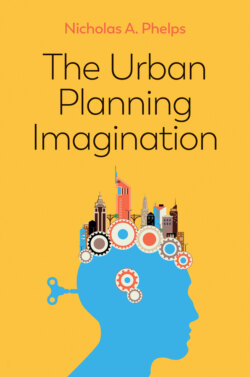Читать книгу The Urban Planning Imagination - Nicholas A. Phelps - Страница 23
Macro-historical change: empires, economic systems and states
ОглавлениеIf, in the present, urban planning and its effects are hard to define (Reade, 1983; Wildavsky, 1973), in the longer sweep of history it is clear that ‘no city, however arbitrary its form may appear to us, can be said to be unplanned’ (Kostof, 1991: 52). An historical perspective can help uncover the ebb, flow and travel of planning ideas.
‘Great cities with long histories are palimpsests, the developments of one era self-replenishing and half-replacing those of earlier times’ (Corfield, 2013: 837). However, the term ‘palimpsest’ can evoke an excessive sense of continuity. There are discontinuities apparent in the making of cities – as with Mexico City’s Plaza de las Tres Culturas (figure 2.2) – whether we are concerned with the spans of time taking us back to ancient history or those of an individual’s lifetime. China may be exceptional as the one continuing urban civilization without permanent interruption (Morris, 1994: 1–2). Paradoxically, the continuity in Chinese civilization may be due to the ephemerality of its imperial city building since, unlike their Roman counterparts, Chinese cities were not built with monuments for eternity (Laurence, 2013). Evidence indicates the inert layering of development in the case of ancient civilizations where ‘the past was not seen as something to understand on its own terms, but rather a source of ideas to reinforce contemporary ideas and practices’ (Smith and Hein, 2018: 109). Modern empires, by contrast, drew on the past but also innovated.
Figure 2.2 Plaza de las Tres Culturas, Mexico City
Source: author
The interactions of macro-historical layers reveal some of the breadth of the urban planning imagination. Different metaphors that have been associated with the city provide clues to the transformative potential of urban planning interventions. If the city is organized according to cosmological principles, it may be entirely resistant to urban planning. However, ‘if the city is a machine that must function effectively, it is subject to obsolescence, and needs constant tuning and updating … If the city is an organism … it can become pathological, and interventions will be in the form of surgery’ (Kostof, 1991: 16).
Capitalism, for all its seeming inevitability, is the product of an eventful history. The emergence of capitalism might itself be considered an event (Sewell, 2008: 530); an event by no means inevitable or universal – an easily overlooked insight that must continue to inform alternative urban planning imaginaries, as I discuss in the next chapter. Nor does it totally erase preceding systems, as these continue to play into the urban planning imagination. For example, the UK liberal market in the exchange of land and property operates with a feudal pattern of land ownership and might be considered socialist in its allocation of the rights to development on land. Nevertheless, capitalism is a system that continues to ‘colonize’ not only activities (such as the production of culture) but also parts of the world (for example, societies across Africa based significantly on subsistence agriculture) that are distinctly non-capitalist. The temporality of capitalism is ‘composite and contradictory, simultaneously still and hyper-eventful’ (Sewell, 2008: 517), producing both ‘spatial fixes’ and ‘spatial switching’ (Harvey, 1985) of investment in and out of cities.
